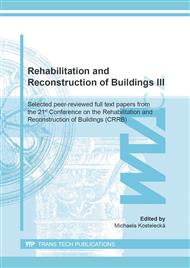p.10
p.15
p.24
p.32
p.39
p.45
p.51
p.57
p.65
Mechanical Properties of Mortars Based on Roman Cement with the Addition of Power Plant Fly Ash
Abstract:
Roman cement is a historic hydraulic binder, prepared by firing of limestone with high proportion of clay minerals, usually at temperatures below the sintering point. The firing temperatures of Roman cements range from 800 to 1200°C. At present, this binder is considered to be a promising material with a low carbon footprint and a long lifetime. The properties of Roman cement are influenced by many factors, especially raw materials composition and firing conditions. On the other hand, a disadvantage of mortars based on Roman cement is a slow increase of initial strength. In this paper, the influence of power fly ash admixture on the dynamics of initial strength increase was experimentally investigated. The characteristics of mortars with admixtures were compared with the properties of reference mortar without admixtures. The Roman cement Vicat Prompt TM Natural Cement (manufactured by Vicat SA, French company) was used as a binder. Based on the results of the experiment it can be stated that mortars with the admixture of power plant fly ash show higher dynamics of the increase of initial strengths than the reference mixture.
Info:
Periodical:
Pages:
39-44
Citation:
Online since:
October 2020
Authors:
Keywords:
Price:
Сopyright:
© 2020 Trans Tech Publications Ltd. All Rights Reserved
Share:
Citation:


